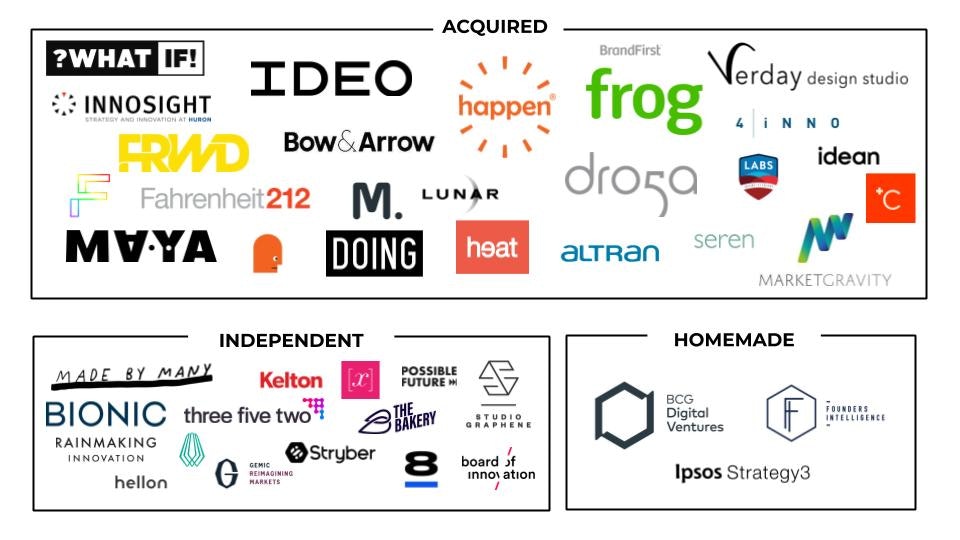Most corporate innovation projects begin with hiring a consultant. But — much like tax returns — no one ever gets taught how to work properly with consultants.
As a result, most people don’t get the most out of consulting engagements and often miss opportunities to be great clients and use the project to accelerate towards real-world outcomes. That can mean >£200k wasted and reputations damaged.
Mismanaged innovation projects can mean >£200k wasted.
Over the last few years, I’ve been a client and now I'm a consultant and I see the same issues playing out time and time again. Let’s get better at it.
Now it’s important to point out here that I’m not just talking about the specific person or team that has commissioned the project — I’m also talking about all the functions or people that interact with the project and can benefit from its outcome.
The start
Set up a deal room. You need the consulting team to understand your business as quickly as possible. In M&A we use 'deal rooms' — secure halfway houses that contain all the relevant information on a company so that the acquirer can do due diligence.
Set one of these up for consultants to use, so they can get a quick overview of the business. These don’t replace one-to-one interviews, but they give a lot of internal context that gives the innovation the best foundations to be built from. Not doing this means time wasted sourcing documents and missing parts of the story, making the innovation less believable.
You need a temporary team dedicated to working with the consultants and are incentivised on the project coming to life i.e. build it into their objectives or offer a revenue share in the venture or investment succeeding. These sponsors can change through a project, but think about who’s best to help external teams navigate your organisational politics and realities. This needs to be someone fairly senior with internal clout. You, the project sponsor, and the c-suite need to publicly endorse them to ensure everyone throws their diaries open to the project.
If you’re on the outside of the project and want to get involved, stick your hand up and organise sessions with the consulting team. These projects contain a lot of senior leadership facetime, this is a great opportunity for you to get noticed and step up. It is always worth getting a team member who is passionate about a project to take a leadership role. The most golden opportunity will die if no one is passionate about it…
Have an idea of what funding or capital is available to turn the concept or Phase 1 project into reality. This can also be an opportunity to create fresh business case formats and have clear conversations with the CFO or c-suite as to what the investment criteria are for growth projects — in order to make them fundable.
If you can't have uncomfortable conversations about the project, its life is limited.
Set the culture. In my work in growth and innovation we like uncomfortable conversations, (from “the Mom Test” by Rob Fitzpatrick) to the one question everyone is afraid of — as one client put it — “OMG moments turning into OMFG moments”. Depending on your company, it can take a while to get that level of comfort established — but you can take a shortcut to this if leaders say clearly that 'this is important, this is a safe open conversation, nothing is off the table.' This may sound obvious, but until teams hear it many remain closed or tactical on what they share. Equally, if leadership can’t say that, it points towards the limited life expectancy of the innovation.

The kick-off
Set very clear expectations of what you need to achieve and lay out all the internal constraints — funding levels, off-limit focus areas — you believe are real. I often find half of these turn out to be internal folk tales so it's great to get them on the table to be tested.
Get comfortable with being uncomfortable. One of the ideas inhouse employees find it hard to get used to is that your customer markets don’t care about your internal problems or past failures.
There are prolonged periods in the messy middle when you don't know what to tell your bosses.
The messy middle
From here it gets a bit unsexy for a while. You’re going to have prolonged periods where research/analysis/workshops/prototyping etc. is taking place, more questions are arising and you’ve no idea what this means for the solution or what to tell your bosses when they ask “have these guys you got in solved it yet?”. This is where you need to manage both the consultancy and the internal PR deftly.
- Work with the consultancy to create milestones or quick wins that throw off evidence, progress or highlight problems that you can start to use internally to build faith for funding and support.
- Get internal teams to use Miro storyboards, town halls or internal podcasts (your comms team) to share openly what the project is highlighting from the market or building. Ask the organiser the question: 'How do you help bring this to life? Reach out to the team.' Avoid any secrecy or a big reveal moment at the end of the project.
Bring in the sales team and ensure you can incentivise whatever the new thing is to be sold or invested in and identify customers to talk to ASAP.
- The consultancy will be profiling the customer needs.
- You need to be bringing the sales organisation to the table and getting them excited about selling. Its the only way you’ll get the project to scale.
Bring in your strategy, corporate development and any other power players in the business to ensure they’re bought in. They can be powerful blockers and ideally if it’s a buy-build-partner opportunity you’re chasing, it will take consensus building to activate all the growth levers in your business.
Trust the process, be impatient and ask tons of questions.
The 'we're doomed' moment is the best moment of the project because it means people have engaged.
The 'we’re doomed' moment:
There’s a moment in almost any project where you or your colleagues might conclude 'This is all too much', 'Where is this going?!', 'Oh god, we’re so behind the market', 'We could never sell this', 'We’ll never get the funding to buy that company'.
This is the best moment of a project because it usually means people have engaged; they’re thinking through the impact or the amount of new information has so totally shellshocked them that they’re disorientated and way out of their comfort zones.
This is the moment when the corporate team need to be on the front foot, not the consultants. The consultants may have helped get the project this far, but it is the internal lead that needs to get the organisation to understand that change needs to come quickly and everyone has to roll up their sleeves and grasp the opportunity. As one CEO put it to us, the consultants: “Your job is to be there in the room to help deliver the baby, but you’re not the father, you better bloody not be the father or we’ll have problems”.
Big bank events always fail. You need a staggered set of quick wins.
The 'we can do this' moment
Depending on how long a project you’ve got, ideally try to build in some wins: a prototype, a customer contract, a signed-off business case or completed transaction or investment. Big bang events always fail, you need to get a staggered set of quick wins to start building the momentum for your team.
Be realistic about what gaps you have in your company to make the project happen. Often there can be a temptation to run the solution on the cheap. This can be a result of P&L constraints you have or access to the funding but remain realistic as to how much this dilutes the solution for your customer and how much value you can capture.
Work with the consultancy to build a vision and a roadmap so you can sell the story of how the new product or service will work. Use this internally but also quickly tell the market and key customers. Often any traction from strategic customers will help you validate and build momentum to get funding.
Avoid the emperor's new clothes moment.
The next steps
Avoid the emperor’s new clothes moment — verify the solution and make sure the roadmap is widely understood and communicated in the formats that will help it glide through whatever it faces next: board approval, the second phase, build or integration.
Be relentless with continuing the momentum built through the project — “Momentum solves 80% of your problems” as John C. Maxwell said. So ensure that the next step— be it funding or approval — is lined up to land as close to the end of the project as possible. I’ve seen many projects derailed by months of hang time waiting for decisions as the market moves on, internal sales targets are missed and the company misses the wave.
Be prepared for a fight. Use the consultancy to arm you to the teeth with the customer’s needs, reasons to believe, return metrics, prototypes, customer traction and with that armoury get what you need so the innovation gets to the market and scales, only then is the job done… until the next one.

